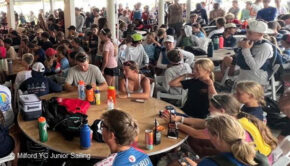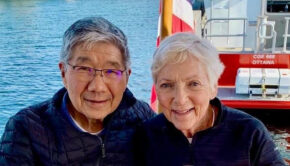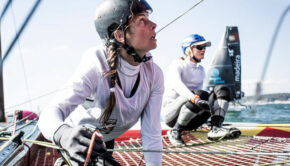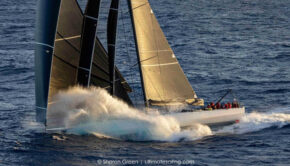Jules Verne: A day to forget
Published on January 14th, 2021
(January 14, 2021; Day 5) – For co-skippers Franck Cammas and Charles Caudrelier, it has been a day to forget. In their effort to secure the Jules Verne Trophy, the miles gained over the record holder during the descent of the North Atlantic have melted away to nothing. Going from a 140 nm lead this morning, the meter has slipped into the red late in the afternoon to the tune of 12.9 nm.
The reason for this is that since the end of last night, the men on the 32m Maxi Edmond de Rothschild have been ensnared in the doldrums and it’s the light airs version with slow progress, which has been reserved for them. Faced with these weather hazards, which are completely unpredictable in this intertropical convergence zone, the only option is patience.
Aboard the latest of the Gitanas, these calmer times have been put to good use to do a complete check of the boat and recharge the batteries, despite the stifling heat, which has gatecrashed the insides of the foiling giant.
The entry into the doldrums was brutal for the six sailors. “It came just as day broke and the half-light gradually became brighter,” noted crewman Morgan Lagravière. “We began to see the first squalls appearing on the radar. We were only mildly suspicious but then the moment we fell under the influence of the squall, the wind picked up and we got nailed by a serious header and, fairly swiftly, we had to rush to the sheets to prevent the boat from heeling over too far!
“It rapidly became a case of action stations! We had to roll in the headsail, the large jib, so we could switch to a sail better suited to sailing close-hauled. It all happened in the blink of an eye. We didn’t have the time to ask any questions and a few minutes later we all had a good shower, making the most of the end of the squall!”
Since this squall rolled through, the wind has vanished from the zone in question. And this is the case for miles around. As a result, the team aboard the blue flying maxi-trimaran have no other option than to just grin and bear it and try to exploit the slightest puff of air in the sails to free themselves from the clutches of the doldrums.
“We have very calm weather, clear skies and small cumulus, reminiscent of summer, not the colours synonymous with a classic doldrums,” admitted Cammas. “So for now, there are no black squalls and none of the usual wind. We still have 60 to 70 miles to go in the light airs before we discover the winds of the southern hemisphere so there’s still a very long way to go.
“We’d like to hook onto the wind that’s ahead of us, as the more miles we tick off now, the more they will multiply later, creating a concertina effect. Right now, we’re in the middle and it’s very, very calm weather. We’ll get all the possible sail area aloft to extricate ourselves.”
Today won’t be one to remember with any fondness on this attempt, but aboard the boat, the six members of the crew know how to get things back in perspective and cast their minds forward to the next stage of the programme in the South Atlantic, which is still shaping up to be very interesting.
Position of the Maxi Edmond de Rothschild on 14 January at 16:45 UTC:
Deficit in relation to the record: 12.9 nm
Speed: 2.6 knots
Course: 244°
Team information – Tracker – Facebook
Since their start on January 10 at 01:33 UTC, to beat the round the world record of 40:23:30 set in 2017 by Francis Joyon and the crew of Idec Sport, they must finish prior to February 20 at 00:03:15 UTC.
Crew list:
Franck Cammas and Charles Caudrelier, skippers
David Boileau, trimmer/bowman
Erwan Israël, helm/trimmer
Morgan Lagravière, helm/trimmer
Yann Riou, trimmer/media man
Source: Gitana Team
The rules for the Jules Verne Trophy are simple – it is for the fastest time around the world by any type of yacht with no restrictions on the size of the crew, starting and finishing from the exact line between the Le Créac’h Lighthouse off the tip of Brittany and the Lizard Point in Cornwall. It was first won in 1993, with all nine winners as either catamarans or trimarans. The current challenge is to beat the record time of 40 days 23 hours 30 minutes and 30 seconds set by Francis Joyon and crew on the 31.5m IDEC Sport in 2017.
Record Facts
• Start and finish: a line between Créac’h lighthouse (Isle of Ushant) and Lizard Point (England)
• Course: non-stop around-the-world tour racing without outside assistance via the three Capes (Good Hope, Leeuwin and Horn)
• Minimum distance: 21,600 nautical miles (40,000 kilometres)
• Ratification: World Sailing Speed Record Council, www.sailspeedrecords.com
• Time to beat: 40 days, 23 hours, 30 minutes and 30 seconds
• Average speed: 21.96 knots
• Date of current record: January 2017
• Holder: IDEC SPORT, Francis Joyon and a 5-man crew
Split Time References – Full Crew:
Ushant-Equator: 4d 20h 07 ‘(Spindrift 2 in 2019)
Equator-Cape Aiguilles: 6d 08h 55 ‘(Banque Populaire V in 2012)
Cape Aiguilles-Cape Leeuwin: 4d 09h 32 ‘(IDEC Sport in 2017)
Cape Leuuwin-Cape Horn: 9d 08h 46 ‘(IDEC Sport in 2017)
Cape Horn-Equator: 7d 04h 27 ‘(Banque Populaire V in 2012)
Equator-Ushant: 5d 19h 21 ‘(IDEC Sport in 2017)
Here are the nine that have held the trophy:
2017 – Francis Joyon / IDEC SPORT (31.5m) – 40:23:30:30
2012 – Loïck Peyron / Banque Populaire V (40m) – 45:13:42:53
2010 – Franck Cammas / Groupama 3 (31.5m) – 48:07:44:52
2005 – Bruno Peyron / Orange II (36.8m) – 50:16:20:04
2004 – Olivier De Kersauson / Geronimo (33.8m) – 63:13:59:46
2002 – Bruno Peyron / Orange (32.8m) – 64:08:37:24
1997 – Olivier De Kersauson / Sport-Elec (27.3m) – 71:14:22:08
1994 – Peter Blake, Robin Knox-Johnston / Enza New Zealand (28m) – 74:22:17:22
1993 – Bruno Peyron / Commodore Explorer (28m) – 79:06:15:56










 We’ll keep your information safe.
We’ll keep your information safe.